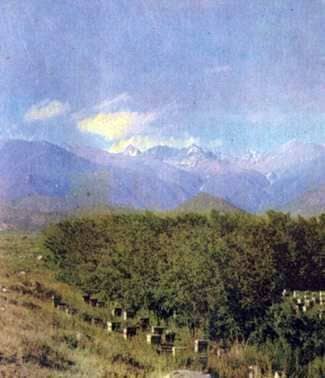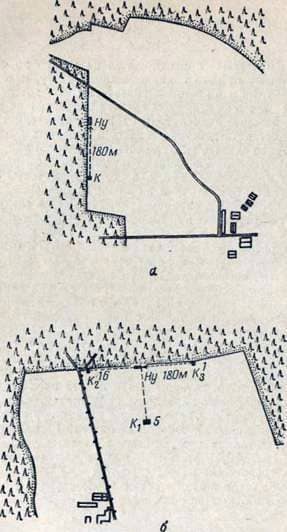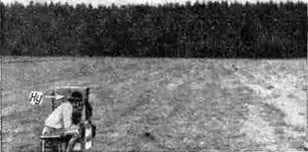
Since bees are guided not only by the sun and the polarized light depending on it, coming from the sky, but also by terrestrial signposts, I would like to know which of these two means of orientation are more important to them. This can be determined if you counteract the action of terrestrial and celestial factors, which is not difficult to do where there is a suitable landscape. The bee family is placed on the edge of the forest, next to a large spacious meadow, and a group of labeled bees are taught to fly along the forest towards the feeder to the south of the hive with syrup. The next morning, the family is transported to an unknown area and set on a forest very similar to the former forest edge, which this time is located from west to east.

Fig. 71. a – a group of numbered bees is trained to fly from the observation beehive (Well) to the feeder (K) along the edge of the forest stretching from north to south; b – the next day the beehive was moved to another place, most bees continued to fly along the edge, although this time it was stretched from east to west. In this case, they clearly disregarded the heavenly compass, preferring it to an earthly landmark. л1 л2, лЗ – feeding troughs. The figures next to them show how many numbered bees appeared near each of them.

Fig. 72. A view from the observation beehive (Well) to a 180-meter fodder table (K) after rearranging it to the edge of a forest stretching from west to east.
The question arises: will the bees now fly to the open field, to the south, according to the directions of the heavenly compass, or to the west along the edge of the forest, using it as the guiding line which, on their flights to the feeder, was also on the right-hand side. In the experiment, most bees flew along the edge of the forest. From figure 71, b, the position of the tables with feeding troughs and the number of tagged and trapped bees from those that arrived at the feeding troughs are seen.

Fig. 73. View from the observation hive (Well) to the edge of the forest, located at a distance of 210 meters. At this distance, the forest as a landmark has lost its importance and bees prefer the heavenly compass.
The second experiment, in which the line of flight of bees from the hive to the feeding trough ran parallel to the forest edge 60 meters away, ended with the same result. But in the third experiment, the forest was 210 meters from the hive; from this distance the trees were visible at an angle of 3-4 degrees and the role of the forest as a landmark was insignificant. He could not stand the competition with the heavenly compass, and in this experience, with the hive rearrangement, the bees flew into the open field, to the south.
Thus, it is possible to create such conditions that the influence of different landmarks will be contrasted with the influence of the sun; depending on whether terrestrial or celestial methods of orientation win, it is not difficult to determine their significance for bees. A nearby forest, street or river bank is of paramount importance as guiding landmarks, a lonely standing tree can not be opposed to orientation in the sky.
Приспособления для пчел. Что добавлять пчелам в сироп.
Biology of the bee family